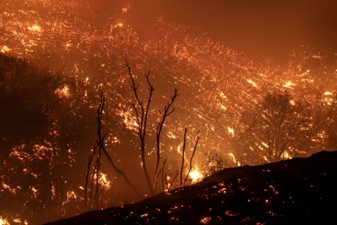Latest Research ~ ESS Collaborations
The Arctic ecosystem is changing. Fast. Faster than the rates that had been expected from our changing climate. Northern high latitude ecosystems—boreal forest and arctic tundra—are experiencing amplified rates of climate change and are undergoing complex shifts in ecosystem properties. Many of the anticipated changes in soil and vegetative characteristics will contribute to climate warming and provide extreme challenges for wildlife and human societies within the Arctic. To understand these challenges, AirUCI researchers in the Earth System Science department have teamed up to study Arctic ecosystem stability.
Research conducted in AirUCI's Randerson, Czimczik, and Guenther groups points to increased instability in boreal forest ecosystems.
- Rising temperatures set the stage for increasing wildfires.
- Wildfires burn the carbon stored in vegetation and soils and they encourage replacement plants that consist of larger deciduous shrubs instead of slower-growing conifers.
- Rising temperatures have also prompted an unexpected rise in emissions of isoprene — an important molecule released by plants that influences local climate through its effects on ozone, aerosols, and methane levels in the air.
In Professor Jim Randerson’s research group, AirUCI grad student Jinhyuk Kim led a study that found ecosystems at high latitudes are becoming increasingly unstable as a result of increased wildfires. “We’re seeing higher levels of photosynthesis that persist for decades after fire,” said Jinhyuk. “Instead of the evergreen conifer forest coming back right away, in some regions we see a long-term replacement of these forests with faster-growing species.” Jinhyuk reflected on the broader implications of the research: “We can see the environment is unstable, and that there are complex interactions from not only the changing plant communities but the responses of those plants to the rapidly changing climate.”
 In a complementary study led by Allison Welch, AirUCI grad student in Professor Claudia Czimczik’s group, her team explored plant expansion across the Arctic ecosystem. “With increasing temperatures and wildfire activity, we’re seeing increased growth of bigger, deciduous shrubs,” said Allison. “Shallower organic layers mean less insulation for the underlying Arctic permafrost, which carries vast reserves of frozen organic matter that, if thawed, may release planet-warming gases like carbon dioxide into the atmosphere.”
In a complementary study led by Allison Welch, AirUCI grad student in Professor Claudia Czimczik’s group, her team explored plant expansion across the Arctic ecosystem. “With increasing temperatures and wildfire activity, we’re seeing increased growth of bigger, deciduous shrubs,” said Allison. “Shallower organic layers mean less insulation for the underlying Arctic permafrost, which carries vast reserves of frozen organic matter that, if thawed, may release planet-warming gases like carbon dioxide into the atmosphere.”
Hui Wang, AirUCI grad student in Professor Alex Guenther’s group, conducted a third study focused on an unexpected rise in emissions of isoprene, an important precursor of ozone and secondary organic aerosols (SOA). Drought is an extreme event known to be important for regulating isoprene emission but is omitted in most isoprene emission models. Isoprene plays a significant role in tropospheric chemistry due to the large amount of emission and its high chemical reactivity. It is the major species of Biogenic Volatile Organic Compounds (BVOCs) emitted from terrestrial vegetation and accounts for half of global BVOC emissions. “This change will indirectly affect the climate,” said Hui, noting that rising temperatures have prompted plants to release more isoprene.
This is an outstanding example of AirUCI’s collaborative prowess, as three of our highly-cited expert faculty in ESS and their teams worked together to reinforce the findings of three separate research projects. The studies collectively highlight a rapidly changing Arctic ecosystem that is transforming at a faster rate than previously anticipated. “These three studies are examples of how the Arctic is changing more rapidly than previously expected. Increasing wildfire activity, via its effect on vegetation composition, has the potential to accelerate permafrost thaw beyond the rates we expected from changing climate,” said Claudia, emphasizing the urgent need for attention.

